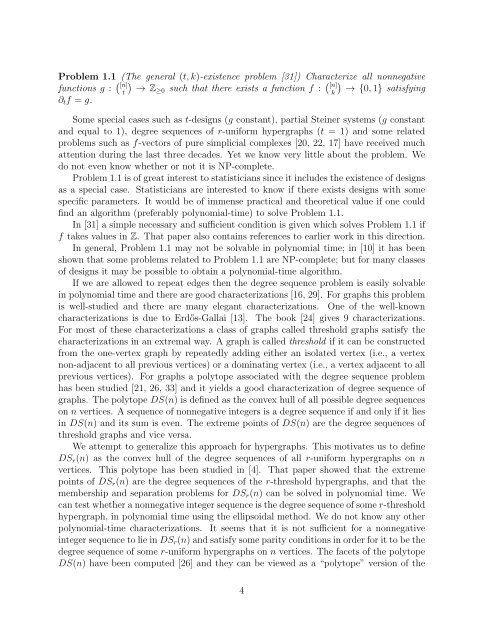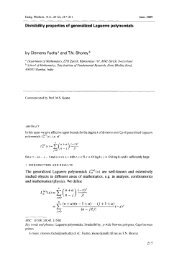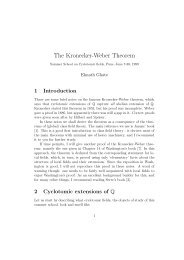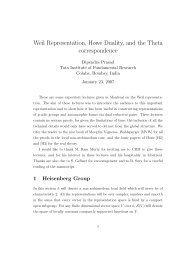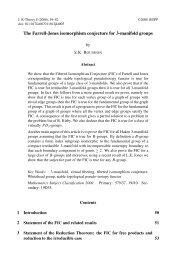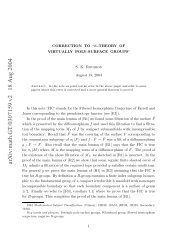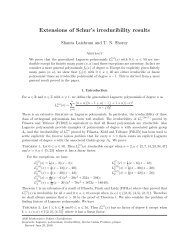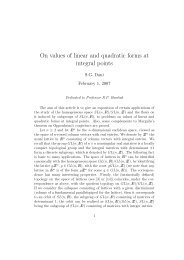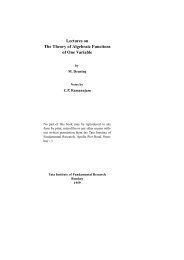Curriculum Vitae - Tata Institute of Fundamental Research
Curriculum Vitae - Tata Institute of Fundamental Research
Curriculum Vitae - Tata Institute of Fundamental Research
You also want an ePaper? Increase the reach of your titles
YUMPU automatically turns print PDFs into web optimized ePapers that Google loves.
Problem 1.1 (The general (t, k)-existence problem [31]) Characterize all nonnegativefunctions g : ( )[n]t → Z≥0 such that there exists a function f : ( )[n]k → {0, 1} satisfying∂ t f = g.Some special cases such as t-designs (g constant), partial Steiner systems (g constantand equal to 1), degree sequences <strong>of</strong> r-uniform hypergraphs (t = 1) and some relatedproblems such as f-vectors <strong>of</strong> pure simplicial complexes [20, 22, 17] have received muchattention during the last three decades. Yet we know very little about the problem. Wedo not even know whether or not it is NP-complete.Problem 1.1 is <strong>of</strong> great interest to statisticians since it includes the existence <strong>of</strong> designsas a special case. Statisticians are interested to know if there exists designs with somespecific parameters. It would be <strong>of</strong> immense practical and theoretical value if one couldfind an algorithm (preferably polynomial-time) to solve Problem 1.1.In [31] a simple necessary and sufficient condition is given which solves Problem 1.1 iff takes values in Z. That paper also contains references to earlier work in this direction.In general, Problem 1.1 may not be solvable in polynomial time; in [10] it has beenshown that some problems related to Problem 1.1 are NP-complete; but for many classes<strong>of</strong> designs it may be possible to obtain a polynomial-time algorithm.If we are allowed to repeat edges then the degree sequence problem is easily solvablein polynomial time and there are good characterizations [16, 29]. For graphs this problemis well-studied and there are many elegant characterizations. One <strong>of</strong> the well-knowncharacterizations is due to Erdős-Gallai [13]. The book [24] gives 9 characterizations.For most <strong>of</strong> these characterizations a class <strong>of</strong> graphs called threshold graphs satisfy thecharacterizations in an extremal way. A graph is called threshold if it can be constructedfrom the one-vertex graph by repeatedly adding either an isolated vertex (i.e., a vertexnon-adjacent to all previous vertices) or a dominating vertex (i.e., a vertex adjacent to allprevious vertices). For graphs a polytope associated with the degree sequence problemhas been studied [21, 26, 33] and it yields a good characterization <strong>of</strong> degree sequence <strong>of</strong>graphs. The polytope DS(n) is defined as the convex hull <strong>of</strong> all possible degree sequenceson n vertices. A sequence <strong>of</strong> nonnegative integers is a degree sequence if and only if it liesin DS(n) and its sum is even. The extreme points <strong>of</strong> DS(n) are the degree sequences <strong>of</strong>threshold graphs and vice versa.We attempt to generalize this approach for hypergraphs. This motivates us to defineDS r (n) as the convex hull <strong>of</strong> the degree sequences <strong>of</strong> all r-uniform hypergraphs on nvertices. This polytope has been studied in [4]. That paper showed that the extremepoints <strong>of</strong> DS r (n) are the degree sequences <strong>of</strong> the r-threshold hypergraphs, and that themembership and separation problems for DS r (n) can be solved in polynomial time. Wecan test whether a nonnegative integer sequence is the degree sequence <strong>of</strong> some r-thresholdhypergraph, in polynomial time using the ellipsoidal method. We do not know any otherpolynomial-time characterizations. It seems that it is not sufficient for a nonnegativeinteger sequence to lie in DS r (n) and satisfy some parity conditions in order for it to be thedegree sequence <strong>of</strong> some r-uniform hypergraphs on n vertices. The facets <strong>of</strong> the polytopeDS(n) have been computed [26] and they can be viewed as a “polytope” version <strong>of</strong> the4


